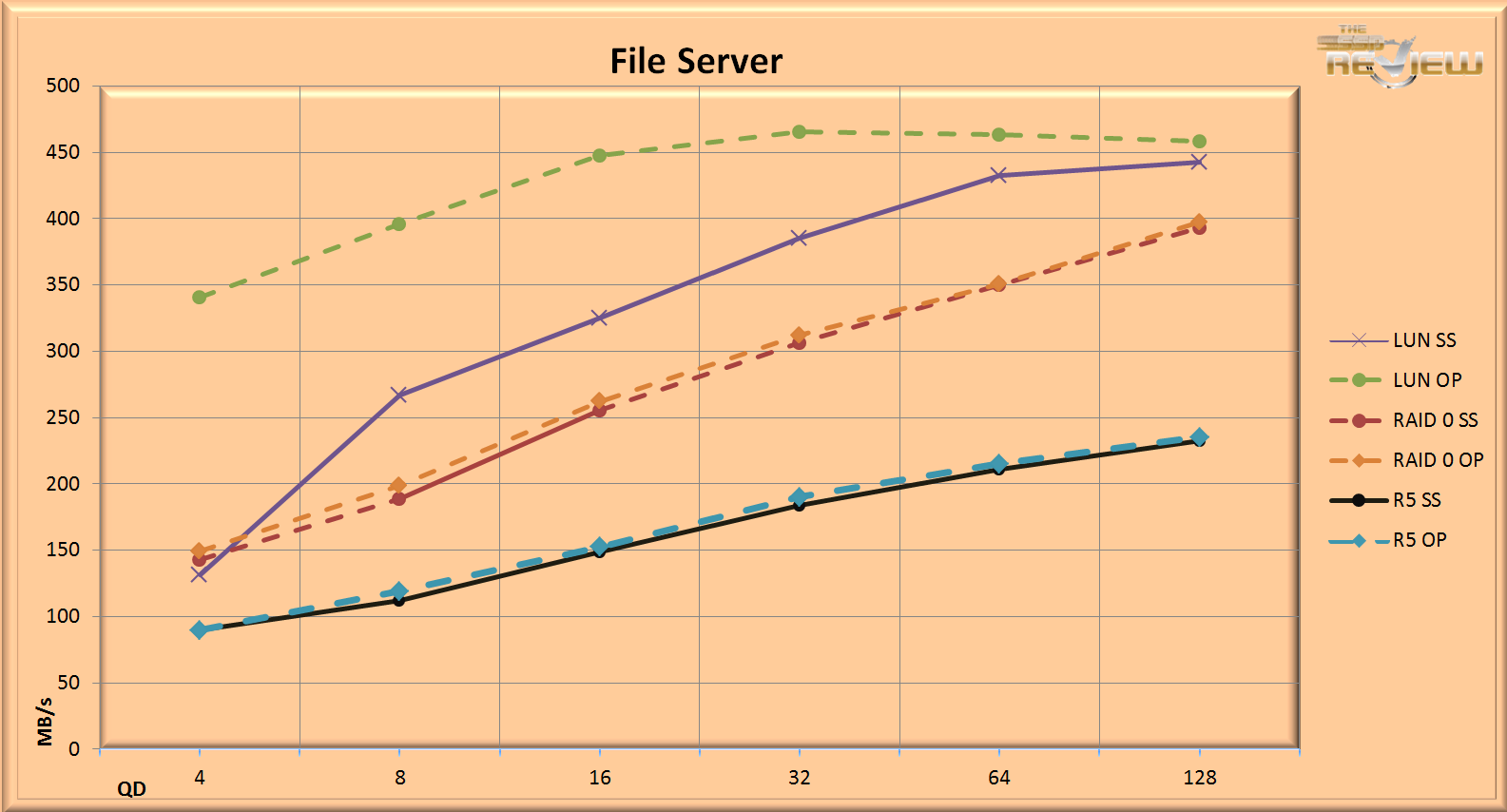800 GB SERVER PROFILES
The File Server profile emulates usage in a file server environment with a vast range of file sizes being accessed simultaneously. This type of file access is 80% read and 20% write.
The LUN test results easily win the File Server testing, coming in at 434 MB/s in steady state at QD64 and 463 MB/s overprovisioned at the same QD. The RAID 0 Steady State and Overprovisioned results mirror each other closely with a peak of 392 MB/s at QD128.
RAID 5 scores well here with a lower percentage of write operations. With these read-centric workloads RAID 5 comes in with a peak of 235 MB/s at QD128.
The Email profile is an emulation of a mail server, with a 50% Read and 50% Write mixed workload with very small 8KB files. This can be a very stressful test for even the best of drives. The Intel 910 is well suited for this kind of loading and enjoys high marks with all of the different configurations, with the exception of the RAID 5 results. Again, we feel that the low RAID 5 results are indicative of a Windows limitation, with minimal gains from Overprovisioning signaling a performance ceiling.
The LUN Steady State results do drop from a peak of 289 MB/s at QD32 to 254MB/s at QD64 and 128, With Overprovisioning there is no loss at the higher QD, presumably due to leveraging the better write performance that is inherent with extra OP.
RAID 0 results score very well here as well, coming in with 270MB/s at QD128, and jumping to 289MB/s with overprovisioning.
The Database/OLTP (On-Line Transaction Processing) profile is another heavy-usage type of access that can bring many drives, even those with superior write performance, to their knees given Steady State conditions. With small 8K random data being read at 66% and written simultaneously at 33%, this is a very demanding workload.
This type of application is sure to be one of the environments that this SSD will deploy into, with PCIe SSDs already enjoying great penetration into the financial sector. Low latencies and high workload performance are attributes that are almost tailor made for OLTP processing, and here the 910 delivers.
The performance of the separate LUNs is outstanding, particularly when utilized with overprovisioning. In the financial sector Price per GB is secondary to raw performance, so these OP results are particularly relevant. Topping out at a relatively low QD of 32 with 363MB/s, and without overprovisioning peaking at QD128 with 311MB/s.
RAID 0 also performs well but has a hard time matching the stellar LUN performance here, topping out at 315MB/s at QD128.
RAID 5 does surprisingly well at this metric as well, with 150MB/s at QD128.
The Web Server profile is read only over a wide range of file sizes simultaneously. This read only profile also highlights the blazing speed of the 910 rather well. Read speed is largely unaffected by steady state conditions. All types of configurations, the slower RAID 5 as well, score roughly between 990 MB/s and 950MB/s.
 The SSD Review The Worlds Dedicated SSD Education and Review Resource |
The SSD Review The Worlds Dedicated SSD Education and Review Resource | 
Simply Outstanding Review Paul!
Thanks, this one was my pleasure for sure. The 910 is one of the best SSDs that i have been lucky enough to test. Really shes a beast, just an awesome performer 🙂
When is this hitting the market? I can’t find it anywhere…
This looks like a dream product for VMware folks. Would it be possible to have PCI SSD reviews indicate whether the vendor supports multi-slot usage of the product?
This is going to ROCK with nexenta or any other ZFS product. 2 of those with 4 mirrored drives across those 2 cards…. cant wait enough to test it behind SVC as tier0
I just purchased the 800 GB 910 recently. I wish I would have read this article first because Intel’s documentation is abysmal on two important points (1) you cannot boot from the device, and (2) it appears as 4 devices to the system.
My application is a workstation and I would have liked to be able to boot the O/S from a single 800 GB drive in order to keep things simple. I would have preferred they implemented a hardware RAID controller.
Currently I have it configured in RAID 0 from Windows 7 and the first thing I did was put the paging file there (192 GB) which helps the overall system performance. Also, I have my RAM Disk backing store there so rebooting or shutting down the system is much faster now.
I am interested in tiered storage solutions – can anyone provide a references for something that might work?
Hey guys, what about security? Is there any way to have two of those cards mirrored? In case this card is used to store data files for e.g. an OLTP database it might dramatically increase database performance, but it NEEDS to be 100% bulletproof and data secure! Any ideas?
Yep, since it appears as 2 logical drives to the OS, you can do RAID 1 with the 400 GB (2 logical) and even RAID 5/6 with the 800 GB version (4 logical drives).
El mundo incrible